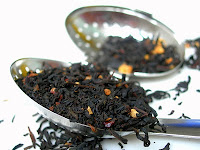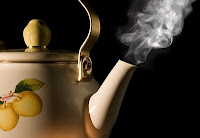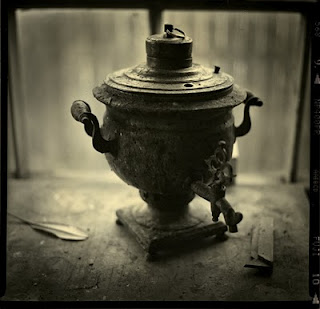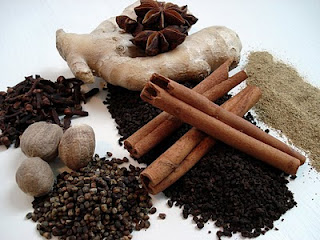But soft! What tea in yonder cup darkly brews? It is the West, and the tea is a black! While greens and oolongs rule the East, the West has been dominated by strong, sweet, and fragrant black teas since the 19th century. In fact, black tea currently accounts for over ninety percent of all tea sold in this hemisphere.
Black tea, like green, white, and oolong, is made from the Camellia sinensis plant. The color of a tea is determined by the degree of processing it undergoes. Like white and oolong teas, leaves destined for black tea are first allowed to wilt. Then, instead of heating the leaves right away (as in green and white) or even bruising them (as in oolong), black tea leaves are lightly crushed to significantly speed up the oxidation process. This process is not ended until the leaves are ready to be dried – resulting in very black, very oxidized tea.
The longer a tea oxidizes in processing, the more caffeine it has. Therefore, an 8oz. mug of properly brewed black tea has 40mg of caffeine, the most of any C. sinensis tea. This is almost as much as a standard soda (45mg), but still not nearly as much as the average 8oz. cup of coffee (about 150mg of caffeine). In addition, each time you re-steep the bag for a new cup, you get about one third of the previous mug’s amount of caffeine. (Stash Tea)
Another effect of the extreme oxidation is that while black tea loses much of its catechins, or antioxidants, it develops other compounds and flavors that require rougher treatment to unlock in brewing. For this reason, steep the bag or loose leaf for three to five minutes in water no cooler than 195 degrees, up to 210 degrees. The boiling point for water at sea level is 212 degrees, so don’t let your tea kettle sit for more than a minute after screaming. Black tea shouldn’t be steeped longer than five minutes lest it turn bitter, but do use freshly boiled water, or you will not experience the full flavor or health benefits of the tea.
A principal reason for black tea’s western domination is that, among the C. sinensis teas, it was uniquely suited for trade. Due to its heavy processing, black tea will retain its flavor for years. Thus, it was often compressed into blocks and used in large and far-reaching shipments or, in some cases, as de facto currency. The lighter teas, which lose their flavor within the year, would not have been worth the investment in the days of travel by sea and by horse.
As black tea infiltrated the West, it became a cultural phenomenon and then a mainstay. Everyone knows of the Brits and their ‘tea time,’ but do you know how common and important to the national culture tea is in Russia? Russia is in fact the largest importer of tea by volume, followed by the UK, Pakistan, and the United States. And while the largest exporters of tea in general are China and India, the largest exporter by volume of black tea is Kenya! Black tea production, because of its trade value, has spread to nearly every corner of the globe, including: Africa, Vietnam, Nepal, Turkey, Thailand, Azerbaijan, Georgia, Russia, Indonesia, Malaysia, and Guatemala.
Because of its strong profile, black tea is also uniquely suited for adding milk and complimentary fruits, juices, and jams. Indeed, the preparation and presentation of tea and its compliments was, for a long time, a household ritual in much of the Western world. In many places, it is still the first thing you will be offered as a guest in another’s home. Note: the popular Western drink, “Chai Tea,” or “Chai Tea Latte,” is a spiced black tea often served with milk!
The leaves and buds of C. sinensis change dramatically during the oxidative stage in cultivation. While caffeine content rises with fermentation, polyphenols, specifically catechins (antioxidants widely believed to improve general health) decrease. This is made up for by the development of theaflavins and other minerals and compounds unique to black and oolong teas. Although little has been proven in the field of tea’s health effects, studies suggest that these theaflavins (not found in green tea) can: inhibit HIV replication, protect against dementia, reduce cholesterol, and help to prevent the development of cancer.
Some popular black teas and tea blends that you might know or ought to try:
- Earl Grey – distinctively fragrant tea, black tea with oil of bergamot
- English Breakfast – blend of blacks, full and rich, most common in UK
- Constant Comment – the founding recipe of the Bigelow Tea Company (who runs America’s only tea plantation), made with orange rinds and sweet spices
- Qi Men Hong Cha (Red Tea) aka Keemun, Chinese Famous black, winey and fruity
- Dian Hong (Yunnan Red) high-end, sweet and malty, fermented with rose and lychee
- Lapsang Souchong (Smoked Tea) smoke-dried over pinewood fires, smoky taste
- Masala Chai (Spiced Tea) aka Chai Tea; from India; incorporates cardamom, cinnamon, ginger, star anise, peppercorn, and cloves; is often served with cold or steamed milk
While most people have had black tea at some point, not many people know the full variety available or the differences between them. I urge you to explore black teas by finding a sampler or ordering tea the next time you’re at a cafe or restaurant. Try adding milk or sugar, as well. If you already have a favorite black tea blend or product, leave it here in the comments.
Leave your feedback and share this page to keep the discussion going!
Here’s a low-cost, five-star-rated tea (sampler)
to start you on your journey. This sampler includes the most popular black teas to help you find your preference amidst the spice of Chai Tea, the sweet citrus of Orange Spice, or the pure, black richness of English Breakfast. If you’re new to tea, try it with milk and/or sugar.
Unless otherwise sourced, all information comes from Wikipedia and its prodigious list of sources.
Photo credits: Cinnamon Black Tea by Annadriel
Tea Kettle by yustoprst

 But soft! What tea in yonder cup darkly brews? It is the West, and the tea is a black! While greens and oolongs rule the East, the West has been dominated by strong, sweet, and fragrant black teas since the 19th century. In fact, black tea currently accounts for over ninety percent of all tea sold in this hemisphere.
But soft! What tea in yonder cup darkly brews? It is the West, and the tea is a black! While greens and oolongs rule the East, the West has been dominated by strong, sweet, and fragrant black teas since the 19th century. In fact, black tea currently accounts for over ninety percent of all tea sold in this hemisphere.


2 pings